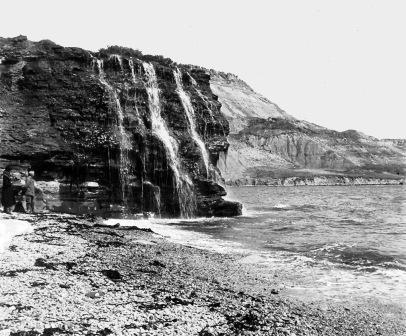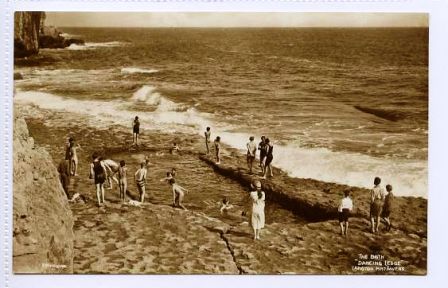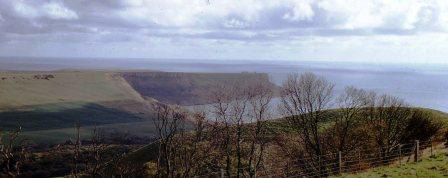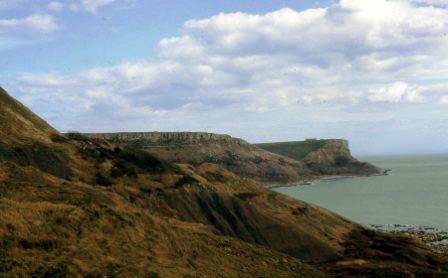EAST DORSET
PURBECK COAST
Rope Lake Head to Encombe
Exmouth to Milford on Sea
including the East Devon & Dorset World Heritage Site
1800-2000
updated: December 23, 2012
< < < Kimmeridge
Hounstout > > >

BNSS MLS Encombe with Hounstout in the background

Dancing Ledge 1920s

from Swyre Head 17-10-1968 (MK)

Egmont Point to St Aldhelm's Head 27-3-1965 (MK)
WORTH MATRAVERS AND WINSPIT.
Bob Alderman
Safety.
Hard hats are required if you go underground in the quarries and perhaps in the Square & Compass pub – low ceilings and beams!
At Winspit the quarry edge is unprotected and there is an immediate vertical drop of about 40 feet to the sea. Similarly if you use the Coast Path to overlook the quarry there is a drop to the quarry floor. Keep away from edges. The quarry faces are stable.
Worth Matravers, along with Langton Matravers is at the centre of the Purbeck stone industry. At Worth the only active quarry is St Aldhelms Quarry (SY 965 762), behind St Aldhelm’s Head. There are several working quarries between Worth and Langton Matravers.
Click here to add text.
The village of Worth Matravers is notable as an essay in Purbeck stone buildings. The nature of the stone means that if readily forms blocks and in some beds splits to form thin roofing tiles. Only rarely does it provide beds that allow significant carving. You will note there are few mullion windows. There is a 16th century house in Corfe Castle with Purbeck stone mullions but it is a rare example. Most of the stone, exported from Swanage, was in the form of paving slabs. The rise of the Purbeck Stone industry probably dates from the 12th century when the then Bishop of Winchester used it for his Palace. Being noted as a man of education and refined taste the nobility followed him in using the stone.
The pub in Worth, “The Square and Compass” (SY 974 775), named for the mason’s tools, has been serving ale for well over 300 years and has just celebrated 100 years of ownership by the same family! There beer is always good and the meat or cheese pasties are to be recommended. In earlier days the name may have been the “Hammers”. Like a lot of the pubs on Purbeck they used to accept stone in payment for beer and sometimes other goods, notably in hard times when the market for stone was low. A 24 x 30 inch paving slab was worth a pint in about 1900. Some of the pubs were run by quarrymen so the exchange seems logical. This has given rise to stories of the Purbeck Penny, a stone coin; romanticised to be an actual circular stone coin. In reality it must have been the exchange of stone for goods. The pub has a small museum with an eclectic collection of fossils and archaeology.
During the Second World War Worth was at the centre of the development of radar. Just to the west of the village, now a Field Study Centre, were aerials of the “Chain Home” early warning radar. There were also arrays associated with the development of “GEE” and “Oboe” the radio locating systems. The development laboratory was in a country house on Durlston Head. Shortly after British Commandos raided a German radar installation on the coast of France the potential vulnerability of this establishment was realised and all was hastily removed to Malvern.
The walk to Winspit takes about half an hour. Leave the “Square and Compass” (reluctantly) and walk down the hill. Keep the pond on your right. There is a terrace of small cottages, “London Row”, keep these to your right and you will find the footpath at the end of the road slightly to your left. Follow the path down the valley.
Across the valley and ahead you will note medieval strip lynchets. This is evidence of long occupation.
As you reach the end of the footpath the quarrying becomes obvious. The stone that was taken from the cliffs was from the Portland beds. The quarry was last worked during the Second World War. The spoil and unwanted stone from earlier quarrying was removed for hardcore; much going to build airfields. The removal of the spoil has left the area unusually “clean” leaving the working faces well expose
In more recent times the quarries have hosted TV productions. A detective mystery found a body at the bottom of a cliff. An episode of Dr Who with Tom Baker was filmed here too. Apparently the Tardis left some of its blue paint on the stone
There are remains of stone working machinery. The derelict buildings once housed a forge, on the left, and circular and frame saws. The remains of the latter can be easily made out. The raised plinth with bolt heads held the rotating parts, flywheels and cranks to drive the saw. The larger rectangular pattern of bolts is the bed ow.
Next to this there is a lowered area. A stone crusher was installed here. In the quarry floor there is a triangle of large bolt heads. A Scotch derrick was fixed here to lift the stone onto the saw bench and possibly into the crusher.
Most of the quarry floor represents 19th century working, the lowered parts occurred in the 20th century. The stone that was worked in the 19th century left the quarry by sea. It was lowered over the cliff edge by gibbet cranes. Holes in the rock can be found where the foot of the vertical post of the crane was seated. Wagons on the sea worn rock ledge below then carried the stone to waiting boats. A track-way can be made out on the ledge when the tide is out. Gibbet cranes again lifted the stone into the boats. The locating holes for these can be found on the ledge. The cliff quarries can be found all along the coast eastwards to Durlston Head.
Notable here are the caves that have been created by the removal of the stone. They are worth a look round but in some recent human passage can be a little nauseous! Few fossils can be found. There is an ammonite just showing above the entrance to the larger cave. Examine the strata above the caves and the ridge to their right. What appear to be tree rings are fracture marks across the face of the stone. Only one stratum seems to display this feature.
If you walk around the inlet to the eastern side of the inlet there is further quarrying. Two of the cave quarries are barred to preserve roosting bats. Further along on the cliff edge there are marks where wedges were inserted to lever a block of stone away. Unusually they remain, as it seems the stone fractured beyond them.